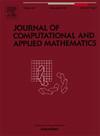非局部色散最优输运:公式与算法
IF 2.6
2区 数学
Q1 MATHEMATICS, APPLIED
Journal of Computational and Applied Mathematics
Pub Date : 2025-10-07
DOI:10.1016/j.cam.2025.117132
引用次数: 0
摘要
我们提出了一个统一的框架,有效地表征具有挑战性的现象,如异质介质中的异常传输和远程记忆效应和相互作用。该框架将代理密度从规定的初始分布传输到终端分布,同时最小化相关的能源成本。在最优输运理论的激励下,我们引入了一个由时空分数阶偏微分方程(PDE)控制的非局部色散最优输运模型。采用一般-近端原始-对偶混合梯度(G-prox PDHG)算法求解NDOT公式,并引入一种基于时空分数阶PDE离散化的新预条件来加速收敛。数值实验——特别是那些以分数阶微分方程解的典型幂函数表示的目标状态的实验——表明,与整数阶模型相比,我们的模型大大降低了动能成本,突出了其对复杂现象(如异质环境中的异常输运)的有效性和适用性。本文章由计算机程序翻译,如有差异,请以英文原文为准。
A nonlocal dispersive optimal transport: Formulation and algorithm
We propose a unified framework that effectively characterizes challenging phenomena such as anomalous transport in heterogeneous media and long-range memory effects and interactions. This framework transports agent densities from a prescribed initial distribution to a terminal distribution while minimizing the associated energy cost. Motivated by optimal transport theory, we introduce a nonlocal dispersive optimal transport (NDOT) model governed by a space–time fractional partial differential equation (PDE). We solve the NDOT formulation using the general-proximal primal–dual hybrid gradient (G-prox PDHG) algorithm, and then introduce a novel preconditioner derived from the discretization of the space–time fractional PDE to accelerate the convergence. Numerical experiments – especially those with target states represented by power functions typical of fractional differential equation solutions – show that our model substantially reduces kinetic energy costs compared with its integer-order counterparts, highlighting its effectiveness and applicability for complex phenomena such as anomalous transport in heterogeneous environments.
求助全文
通过发布文献求助,成功后即可免费获取论文全文。
去求助
来源期刊
CiteScore
5.40
自引率
4.20%
发文量
437
审稿时长
3.0 months
期刊介绍:
The Journal of Computational and Applied Mathematics publishes original papers of high scientific value in all areas of computational and applied mathematics. The main interest of the Journal is in papers that describe and analyze new computational techniques for solving scientific or engineering problems. Also the improved analysis, including the effectiveness and applicability, of existing methods and algorithms is of importance. The computational efficiency (e.g. the convergence, stability, accuracy, ...) should be proved and illustrated by nontrivial numerical examples. Papers describing only variants of existing methods, without adding significant new computational properties are not of interest.
The audience consists of: applied mathematicians, numerical analysts, computational scientists and engineers.

 求助内容:
求助内容: 应助结果提醒方式:
应助结果提醒方式:


